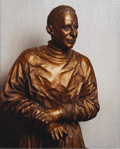



 Antonio Ciccone, charcoal sketch 1987
Antonio Ciccone, charcoal sketch 1987
 Antonio Berti, bronze 1988: Prof. Ennio Muntoni, Fotostudio 72
Antonio Berti, bronze 1988: Prof. Ennio Muntoni, Fotostudio 72
___ Organization of the Association ___ |
Vice President: Alessandro Corsinovi Secretary and Treasurer: Dr. Sergio Balatri |
Address:
Borgo Ognissanti 42 50123 FIRENZE ItaliaE-mail (sgd@asgdd.it)
We received visits.